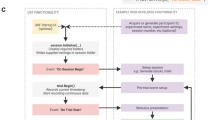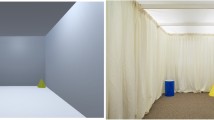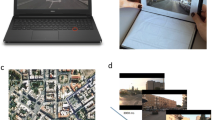Abstract
Human orientation in novel and familiar environments is a complex skill that can involve numerous different strategies. To date, a comprehensive account of how these strategies interrelate at the behavioural level has not been documented, impeding the development of elaborate systems neuroscience models of spatial orientation. Here, we describe a virtual environment test battery designed to assess five of the core strategies used by humans to orient. Our results indicate that the ability to form a cognitive map is highly related to more basic orientation strategies, supporting previous proposals that encoding a cognitive map requires inputs from multiple domains of spatial processing. These findings provide a topology of numerous primary orientation strategies used by humans during orientation and will allow researchers to elaborate on neural models of spatial cognition that currently do not account for how different orientation strategies integrate over time based on environmental conditions.

Similar content being viewed by others
References
Aguirre GK, D’Esposito M (1999) Topographical disorientation: a synthesis and taxonomy. Brain 122:1613–1628
Aguirre GK, Detre JA, Alsop DC, D’Esposito M (1996) The parahippocampus subserves topographical learning in man. Cereb Cortex 6:823–829
Alyan S, McNaughton BL (1999) Hippocampectomized rats are capable of homing by path integration. Behav Neurosci 113:19–31
Baumann O, Chan E, Mattingley JB (2010) Dissociable neural circuits for encoding and retrieval of object locations during active navigation in humans. Neuroimage 49:2816–2825
Bird CM, Burgess N (2008) The hippocampus and memory: insights from spatial processing. Nat Neurosci 9:182–194
Blades M, Medlicott L (1992) Developmental differences in the ability to give route directions from a map. J Enviro Psychol 12:175–185
Bohbot VD, Kalina M, Stepankova K et al (1998) Spatial memory deficits in patients with lesions to the right hippocampus and to the right parahippocampal cortex. Neuropsychologia 36:1217–1238
Bohbot VDV, Iaria GG, Petrides MM (2004) Hippocampal function and spatial memory: evidence from functional neuroimaging in healthy participants and performance of patients with medial temporal lobe resections. Neuropsychology 18:418–425
Bohbot VD, Lerch J, Thorndycraft B et al (2007) Gray matter differences correlate with spontaneous strategies in a human virtual navigation task. J Neurosci 27:10078–10083
Bohil CJ, Alicea B, Biocca FA (2011) Virtual reality in neuroscience research and therapy. Nat Neurosci 12:752–762
Burgess N (2008) Spatial cognition and the brain. Ann NY Acad Sci 1124:77–97
Burgess N, Becker S, King JA, O’Keefe J (2001) Memory for events and their spatial context: models and experiments. Philos Trans R Soc Lond B Biol Sci 356:1493–1503
Byrne PP, Becker SS, Burgess NN (2007) Remembering the past and imagining the future: a neural model of spatial memory and imagery. Psychol Rev 114:340–375
Committeri G, Galati G, Paradis A-L et al (2004) Reference frames for spatial cognition: different brain areas are involved in viewer-, object-, and landmark-centered judgments about object location. J Cogn Neurosci 16:1517–1535
deIpolyi AR, Rankin KP, Mucke L et al (2007) Spatial cognition and the human navigation network in AD and MCI. Neurology 69(986–997):6
Doeller CF, Burgess N (2008) Distinct error-correcting and incidental learning of location relative to landmarks and boundaries. Proc Natl Acad Sci USA 105:5909–5914
Doeller CF, King JA, Burgess N (2008) Parallel striatal and hippocampal systems for landmarks and boundaries in spatial memory. Proc Natl Acad Sci USA 105:5915–5920
Eichenbaum H, Stewart C, Morris RG (1990) Hippocampal representation in place learning. J Neurosci 10:3531–3542
Ekstrom AD, Kahana MJ, Caplan JB et al (2003) Cellular networks underlying human spatial navigation. Nature 425:184–188
Ekstrom AD, Caplan JB, Ho E et al (2005) Human hippocampal theta activity during virtual navigation. Hippocampus 15:881–889
Etchamendy N, Bohbot VD (2007) Spontaneous navigational strategies and performance in the virtual town. Hippocampus 17:595–599
Etienne ASA, Jeffery KJK (2004) Path integration in mammals. Hippocampus 14:180–192
Gallistel CR (1990) The organization of behaviour. Wiley, New York
Gillner S, Mallot HA (1998) Navigation and acquisition of spatial knowledge in a virtual maze. J Cogn Neurosci 10:445–463
Hartley T, Maguire EA, Spiers HJ, Burgess N (2003) The well-worn route and the path less traveled: distinct neural bases of route following and wayfinding in humans. Neuron 37:877–888
Hashimoto R, Tanaka Y, Nakano I (2010) Heading disorientation: a new test and a possible underlying mechanism. Eur Neurol 63:87–93
Hegarty M, Richardson AE, Montello DR et al (2002) Development of a self-report measure of environmental spatial ability. Intelligence 30:425–447
Hegarty M, Montello DR, Richardson AE et al (2006) Spatial abilities at different scales: Individual differences in aptitude-test performance and spatial-layout learning. Intelligence 34:151–176
Iachini I, Iavarone A, Senese VP et al (2009) Visuospatial memory in healthy elderly, AD and MCI: a review. Curr Aging Sci 2:43–59
Iaria G, Barton JJS (2010) Developmental topographical disorientation: a newly discovered cognitive disorder. Exp Brain Res 206:189–196
Iaria G, Petrides M, Dagher A, Pike B (2003) Cognitive strategies dependent on the hippocampus and caudate nucleus in human navigation: variability and change with practice. J Neurosci 23:5945–5952
Iaria G, Chen J, Guariglia C et al (2007) Retrosplenial and hippocampal brain regions in human navigation: complementary functional contributions to the formation and use of cognitive maps. Eur J Neurosci 25:890–899
Iaria G, Lanyon L, Fox C, Giaschi D (2008) Navigational skills correlate with hippocampal fractional anisotropy in humans. Hippocampus 18:335–339
Iaria G, Bogod N, Fox C (2009a) Developmental topographical disorientation: case one. Neuropsychologia 47:30–40
Iaria G, Palermo L, Committeri G, Barton J (2009b) Age differences in the formation and use of cognitive maps. Behav Brain Res 196:187–191
Iglói K, Doeller CF, Berthoz A et al (2010) Lateralized human hippocampal activity predicts navigation based on sequence or place memory. Proc Natl Acad Sci USA 107:14466–14471
Ishikawa T, Montello DR (2006) Spatial knowledge acquisition from direct experience in the environment: individual differences in the development of metric knowledge and the integration of separately learned places. Cogn Psychol 52:93–129
Janzen G, van Turennout M (2004) Selective neural representation of objects relevant for navigation. Nat Neurosci 7:673–677
Kanai R, Rees G (2011) The structural basis of inter-individual differences in human behaviour and cognition. Nat Neurosci 12:231–242
Kearns MJ, Warren WH, Duchon AP, Tarr MJ (2002) Path integration from optic flow and body senses in a homing task. Perception 31:349–374
Kelly D, Gibson B (2007) Spatial navigation: spatial learning in real and virtual environments. Comp Cogn Behav Rev 2:111–124
Kuipers B, Tecuci D, Stankiewicz B (2003) The skeleton in the cognitive map: a computational and empirical exploration. Environ Behav 35:80–106
Liu I, Levy RM, Barton JJS, Iaria G (2011) Age and gender differences in various topographical orientation strategies. Brain Res 1410:112–119
Loomis JM, Klatzky RL, Golledge RG, Philbeck JW (1999) Human navigation by path integration. In: Golledge RG (ed) Wayfinding: cognitive mapping and spatial behavior. Johns Hopkins University Press, Baltimore, pp 125–151
Maguire EA, Burke T, Phillips J, Staunton H (1996) Topographical disorientation following unilateral temporal lobe lesions in humans. Neuropsychologia 34:993–1001
Maguire E, Burgess N, Donnett J et al (1998a) Knowing where and getting there: a human navigation network. Science 280:921–924
Maguire EA, Frith CD, Burgess N et al (1998b) Knowing where things are parahippocampal involvement in encoding object locations in virtual large-scale space. J Cogn Neurosci 10:61–76
Marchette SA, Bakker A, Shelton AL (2011) Cognitive mappers to creatures of habit: differential engagement of place and response learning mechanisms predicts human navigational behavior. J Neurosci 31:15264–15268
McDonald RJ, White NM (1994) Parallel information processing in the water maze: evidence for independent memory systems involving dorsal striatum and hippocampus. Behav Neural Biol 61:260–270
McNaughton BL, Battaglia FP, Jensen O et al (2006) Path integration and the neural basis of the ‘cognitive map’. Nat Neurosci 7:663–678
Mittelstaedt ML, Mittelstaedt H (1980) Homing by path integration in a mammal. Naturwissenschaften 67:566–567
Mou W, Xiao C, McNamara TP (2008) Reference directions and reference objects in spatial memory of a briefly viewed layout. Cognition 108:136–154
Müller M, Wehner R (2010) Path integration provides a scaffold for landmark learning in desert ants. Curr Biol 20:1368–1371
O’Keefe J, Dostrovsky J (1971) The hippocampus as a spatial map. Preliminary evidence from unit activity in the freely-moving rat. Brain Res 34:171–175
O’Keefe J, Nadel L (1978) The hippocampus as a cognitive map. Clarendon Press, Oxford
Owen AM, Milner B, Petrides M, Evans AC (1996) A specific role for the right parahippocampal gyrus in the retrieval of object-location: a positron emission tomography study. J Cogn Neurosci 8:588–602
Packard MG, McGaugh JL (1996) Inactivation of hippocampus or caudate nucleus with lidocaine differentially affects expression of place and response learning. Neurobiol Learn Mem 65:65–72
Piaget J, Inhelder B, Szeminska A (1960) The child’s conception of geometry. Routledge and Kegan Paul, London
Pigott S, Milner B (1993) Memory for different aspects of complex visual scenes after unilateral temporal- or frontal-lobe resection. Neuropsychologia 31:1–15
Pilly PK, Grossberg S (2012) How do spatial learning and memory occur in the brain? Coordinated learning of entorhinal grid cells and hippocampal place cells. J Cogn Neurosci 24:1031–1054
Prestopnik J, Roskos-Ewoldsen B (2000) The relations among wayfinding, strategy use, sense of direction, sex, familiarity, and wayfinding Ability. J Enviro Psychol 20:177–191
Siegel AW, White SH (1975) The development of spatial representations of large-scale environments. Adv Child Dev Behav 10:9–55
Smith MLM, Milner BB (1989) Right hippocampal impairment in the recall of spatial location: encoding deficit or rapid forgetting? Neuropsychologia 27:71–81
Taube JS, Muller RU, Ranck JB (1990) Head-direction cells recorded from the postsubiculum in freely moving rats. I. Description and quantitative analysis. J Neurosci 10:420–435
Thomas KGF, Hsu M, Laurance HE et al (2001) Place learning in virtual space III: investigation of spatial navigation training procedures and their application to fMRI and clinical neuropsychology. Behav Res Methods Instrum Comput 33:21–37
Thompson LT, Best PJ (1990) Long-term stability of the place-field activity of single units recorded from the dorsal hippocampus of freely behaving rats. Brain Res 509:299–308
Thorndyke PW, Hayes-Roth B (1982) Differences in spatial knowledge acquired from maps and navigation. Cogn Psychol 14:560–589
Tolman EC (1948) Cognitive maps in rats and men. Psych Rev 55:189–208
Vann SD, Aggleton JP, Maguire EA (2009) What does the retrosplenial cortex do? Nat Neurosci 10:792–802
White NM, McDonald RJ (2002) Multiple parallel memory systems in the brain of the rat. Neurobiol Learn Mem 77:125–184
Wiener JM, Bücher SJ, Hölscher C (2009) Taxonomy of human wayfinding tasks: a knowledge-based approach. Spat Cog Comp 9:152–165
Wilson MA, McNaughton BL (1993) Dynamics of the hippocampal ensemble code for space. Science 261:1055–1058
Wolbers T, Büchel C (2005) Dissociable retrosplenial and hippocampal contributions to successful formation of survey representations. J Neurosci 25:3333–3340
Wolbers T, Hegarty M (2010) What determines our navigational abilities? Trends Cogn Sci 14:138–146
Wolbers T, Wiener JM, Mallot HA, Büchel C (2007) Differential recruitment of the hippocampus, medial prefrontal cortex, and the human motion complex during path integration in humans. J Neurosci 27:9408–9416
Worsley CL, Recce M, Spiers HJ et al (2001) Path integration following temporal lobectomy in humans. Neuropsychologia 39:452–464
Yoder RM, Clark BJ, Taube JS (2011) Origins of landmark encoding in the brain. Trends Neurosci 34:561–571
Acknowledgments
This research was funded by NSERC (Natural Sciences and Engineering Research Council) Discovery Grant (GI) (Grant number: 354594). A. A. was supported by Alberta Health Services and the Ministry of Human Services as part of the Collaborative Research Grant Initiative: Mental Wellness in Seniors and Persons with Disabilities.
Author information
Authors and Affiliations
Corresponding author
Appendix
Appendix
Additional information on the generation of stimuli for each test is presented below. Each of the orientation tests within the battery is also accessible on our website at www.gettinglost.ca.
Landmark Recognition test
The testing environment consisted of a grid of symmetrical passageways between walls with identical textures. See Fig. 2 for a visual of the environment without landmarks. Twelve different types of objects were created with four similar but different versions of each. Figure 3 presents a visual of one landmark from each of the twelve types. These landmarks were generated randomly in each trial such that only one type of each landmark was ever presented within a single trial. Each landmark was encountered along the pathway (not at intersections), and the first-person motion stopped for 3 s to look at it before continuing along the path. At the end of each video clip, participants were presented with four landmarks within the same category (i.e. benches), and they were asked to identify the one encountered while travelling along the pathway. This test consisted of 12 trials.
Visual depiction of one of the four versions for each of the twelve landmarks. a Bench. b Door—each version had a different pattern on the door. c Fountain. d Greenhouse. e Kiosk—each version had a different texture with an identical shape. f Ladder. g Lamp. h Tempietto. i Topiary. j Tree. k Tree in pot. l Windowed house—each version had a different window pattern
Heading Orientation
The testing environment was similar to the one used in the Landmark Recognition test (see Fig. 2). Landmarks from our group of 48 were randomly selected to be in a video. No video presented two or more landmarks of the same type. Thirty-second video clips were generated that showed three left or right turns being made at each of the landmarks. One of the three landmarks from the video clip was randomly selected and presented at the end of the video when participants indicated whether a left or right turn had been made. All participants were shown the same order of video clips during the experiment.
Sequence Matching test
The testing environment was similar to the one used in the Landmark Recognition test (see Fig. 2), except there were no landmarks placed within the environment. Paths involved sequences of three consecutive left or right turns at each intersection. We generated 30-second video clips of randomized left/right turns. We randomly selected six of these clips and matched them with the identical clip. These composed the ‘same’ trials where the path was identical in each video clip. We also randomly selected six clips and paired them with non-matching video clips. These composed the ‘different’ trials.
Path Integration test
Figure 1 provides a visual depiction of the test environment. Paths were constructed using the edges of right angle triangles as trajectories. The final edge of the path was always the hypotenuse of the triangle. In a third of the trials, participants viewed video clips of a person completing the triangle and ending at the same point that they started. On the other two-thirds of trials, participants saw video clips where the person ended either before or after the starting point. These trials were created by subtracting or adding 30 % of the total time taken to traverse the final edge of the triangle. The order of these trials was randomized for each participant.
Cognitive Map Formation test
Figure 4 presents an aerial view of the virtual city grid and each of the four unique landmarks used in this test. Paths for each trial were created by first generating a randomized path through the city. This path was then randomly clipped into 1-min segments of video. This was done 20 times. We then discarded all videos that did not present at least two of the city landmarks. This resulted in nine one-minute video clips that showed two or more city landmarks. We selected one clip that showed a path between all four landmarks and presented that first to ensure that it was possible for participants to encode the correct spatial arrangement of the city on the first trial. All participants were shown the same order of clips during the experiment to control for between-subject variability in the level of exposure to each of the landmarks.
Cognitive Map Use test
Viewpoints for each of the starting points were randomly selected for one of the four sides or four corners for each of the landmarks. Destinations were selected for each starting point by selecting which landmark resulted in a clear left or right turn from the starting point when traversing the route in the shortest path possible. Each landmark was used as a starting point three times for a total of 12 trials. No viewpoint of a landmark was repeated in the same testing session.
Rights and permissions
About this article
Cite this article
Arnold, A.E.G.F., Burles, F., Krivoruchko, T. et al. Cognitive mapping in humans and its relationship to other orientation skills. Exp Brain Res 224, 359–372 (2013). https://doi.org/10.1007/s00221-012-3316-0
Received:
Accepted:
Published:
Issue Date:
DOI: https://doi.org/10.1007/s00221-012-3316-0







